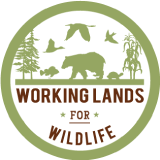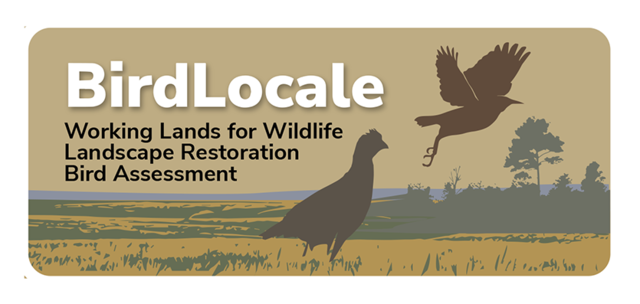-
 Conserving Imperiled Aquatic Species in the UTRB
Conserving Imperiled Aquatic Species in the UTRB
-
by
Web Editor
—
published
Sep 24, 2015
—
last modified
Mar 09, 2022 08:51 PM
—
filed under:
Conservation,
Video,
Conservation Efforts,
UTRB
A team of U.S. Fish and Wildlife Service scientists, with assistance from U.S. Geological Survey, have developed a collaborative conservation strategy examining cost-effective approaches for efforts to conserve and manage 36 imperiled freshwater fish and mussel species in the 22,360 square-mile Upper Tennessee River Basin.
Located in
Training
/
Videos and Webinars
-
 Haywood Waterways Watershed Restoration 2015
Haywood Waterways Watershed Restoration 2015
-
by
Web Editor
—
published
Mar 08, 2017
—
last modified
Mar 09, 2022 09:01 PM
—
filed under:
Video,
Streams,
Conservation Efforts,
Rivers
A look into restoration efforts in Haywood County, NC from the Haywood Waterways Association.
Located in
Training
/
Videos and Webinars
-
 "Riparian" Episode 309 | Tennessee Uncharted
"Riparian" Episode 309 | Tennessee Uncharted
-
by
Web Editor
—
published
Mar 09, 2017
—
last modified
Mar 09, 2022 09:21 PM
—
filed under:
Video,
Streams,
Conservation Efforts,
Rivers
With 2016’s devastating wildfires and learning about riparian zones feeding Tennessee’s waterways, host Erick Baker discovers that sometimes it takes science to restore faith in our ability to take care of our fair state.
Located in
Training
/
Videos and Webinars
-
 We take care of our Natural Resources in Haywood County NC
We take care of our Natural Resources in Haywood County NC
-
by
Web Editor
—
published
Mar 09, 2017
—
last modified
Mar 09, 2022 11:40 PM
—
filed under:
Streams,
Pride of Place,
Video,
Rivers
Our locals and visitors alike take pride in the quality of the water here in Haywood County NC. The agriculture, flora/fauna, wildlife, breweries and more all rely on the quality of our water. Haywood County holds something very precious and rare - water that comes directly from our mountains and nowhere else. We are the only county east of the Mississippi River with headwaters that originate within our county lines. The activity of our community impacts other regions downstream and as award winning author Wendell Berry once said, “Do unto those downstream as you would have those upstream do unto you.” I feel it is our responsibility and duty to safeguard our waterways.
Located in
Training
/
Videos and Webinars
-
 "Cold Water and Hardtack" Episode 308 | Tennessee Uncharted
"Cold Water and Hardtack" Episode 308 | Tennessee Uncharted
-
by
Web Editor
—
published
Mar 09, 2017
—
last modified
Mar 09, 2022 11:45 PM
—
filed under:
Streams,
Pride of Place,
Video,
Rivers
Host Erick Baker and the Tennessee Uncharted crew take us on an adventure that looks to the future of water health and species diversity in Tennessee and pays tribute to the past in a Civil War reenactment.
Located in
Training
/
Videos and Webinars
-
 Hidden Rivers - Preview
Hidden Rivers - Preview
-
by
Web Editor
—
published
Jan 20, 2017
—
last modified
Mar 09, 2022 10:37 PM
—
filed under:
Video,
Pride of Place,
Streams,
Rivers
A short preview of Freshwaters Illustrated forthcoming film series on the vibrant yet little-known life of Southern Appalachian Rivers.
Located in
Training
/
Videos and Webinars
-
 Rivers - More Than Skin Deep
Rivers - More Than Skin Deep
-
by
Web Editor
—
published
Jan 20, 2017
—
last modified
Mar 09, 2022 10:44 PM
—
filed under:
Video,
Pride of Place,
Streams,
Rivers
This is a collection of some clips from the National Park Service of some of some of the fish species observed and filmed while snorkeling in several rivers in Southern Appalachia. The diversity that can be found below the surface of these rivers and others throughout North America is unreal. A fish species list is included at the end. Get below the surface and see what you're missing! Video by BlueBlood.
Located in
Training
/
Videos and Webinars
-
 Fishy Fragments
Fishy Fragments
-
by
Web Editor
—
published
Jan 20, 2017
—
last modified
Mar 09, 2022 10:50 PM
—
filed under:
Video,
Pride of Place,
Streams,
Rivers
These clips are a short snapshot into the many hours of footage captured below the rivers. A longer documentary will be compiled in 2016 including brook trout, stone nest building, colorful darters, and many other interesting species and behaviors. Video by Eric Malone.
Located in
Training
/
Videos and Webinars
-
 Southern Salvelinus - Brook Trout Below the Mason-Dixon
Southern Salvelinus - Brook Trout Below the Mason-Dixon
-
by
Web Editor
—
published
Jan 20, 2017
—
last modified
Mar 09, 2022 10:56 PM
—
filed under:
Streams,
Pride of Place,
Video,
Rivers
Southern Appalachian Brook Trout are a geographically isolated strain of Brook Trout (Salvelinus fontinalis) that are facing a realistic possibility of disappearing. They are a valuable indicator species and the decline in brook trout populations is a reflection of the degradation of our beautiful streams. They are the only native trout (technically a char) to the Eastern United States. Because of the introduction of invasive Rainbow Trout (from the Western US) through state fish stocking programs, they are being out competed and brook trout populations are being even further reduced. Video by BlueBlood.
Located in
Training
/
Videos and Webinars
-
 TN Wild Side - Buffalo Run
TN Wild Side - Buffalo Run
-
by
Web Editor
—
published
Jan 20, 2017
—
last modified
Mar 09, 2022 11:03 PM
—
filed under:
Video,
Pride of Place,
Streams,
Rivers
We've all seen the pictures and heard the thrilling stories of the great buffalo stampedes of the old West. Those involved the massive, furry, four-legged critters that once dominated the Great Plains. But the Buffalo we're talking about today swim in Tellico Reservoir except for a few days in early April each year. That's when thousands of buffalo fish make their spawning runs into nearby Citico Creek. The dark-colored fish quickly turn the creek into a frenzy of splashing water. The fishing's not bad either, as Wild Side Guide Alan Griggs shows us.
Located in
Training
/
Videos and Webinars


